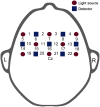Predicting poststroke dyskinesia with resting-state functional connectivity in the motor network
- PMID: 37025568
- PMCID: PMC10072005
- DOI: 10.1117/1.NPh.10.2.025001
Predicting poststroke dyskinesia with resting-state functional connectivity in the motor network
Abstract
Significance: Motor function evaluation is essential for poststroke dyskinesia rehabilitation. Neuroimaging techniques combined with machine learning help decode a patient's functional status. However, more research is needed to investigate how individual brain function information predicts the dyskinesia degree of stroke patients.
Aim: We investigated stroke patients' motor network reorganization and proposed a machine learning-based method to predict the patients' motor dysfunction.
Approach: Near-infrared spectroscopy (NIRS) was used to measure hemodynamic signals of the motor cortex in the resting state (RS) from 11 healthy subjects and 31 stroke patients, 15 with mild dyskinesia (Mild), and 16 with moderate-to-severe dyskinesia (MtS). The graph theory was used to analyze the motor network characteristics.
Results: The small-world properties of the motor network were significantly different between groups: (1) clustering coefficient, local efficiency, and transitivity: MtS > Mild > Healthy and (2) global efficiency: MtS < Mild < Healthy. These four properties linearly correlated with patients' Fugl-Meyer Assessment scores. Using the small-world properties as features, we constructed support vector machine (SVM) models that classified the three groups of subjects with an accuracy of 85.7%.
Conclusions: Our results show that NIRS, RS functional connectivity, and SVM together constitute an effective method for assessing the poststroke dyskinesia degree at the individual level.
Keywords: dyskinesia; machine learning; motor network; near-infrared spectroscopy; stroke.
© 2023 The Authors.
Figures






Similar articles
-
Reorganization of prefrontal network in stroke patients with dyskinesias: evidence from resting-state functional near-infrared spectroscopy.J Biophotonics. 2022 Jul;15(7):e202200014. doi: 10.1002/jbio.202200014. Epub 2022 Apr 9. J Biophotonics. 2022. PMID: 35324088
-
The relationship between the prefrontal cortex and limb motor function in stroke: A study based on resting-state functional near-infrared spectroscopy.Brain Res. 2023 Apr 15;1805:148269. doi: 10.1016/j.brainres.2023.148269. Epub 2023 Feb 1. Brain Res. 2023. PMID: 36736871
-
Resting-state functional connectivity for determining outcomes in upper extremity function after stroke: A functional near-infrared spectroscopy study.Front Neurol. 2022 Nov 9;13:965856. doi: 10.3389/fneur.2022.965856. eCollection 2022. Front Neurol. 2022. PMID: 36438935 Free PMC article.
-
Multimodal Neuroimaging Using Concurrent EEG/fNIRS for Poststroke Recovery Assessment: An Exploratory Study.Neurorehabil Neural Repair. 2020 Dec;34(12):1099-1110. doi: 10.1177/1545968320969937. Epub 2020 Nov 16. Neurorehabil Neural Repair. 2020. PMID: 33190571
-
Cerebral network disorders after stroke: evidence from imaging-based connectivity analyses of active and resting brain states in humans.J Physiol. 2013 Jan 1;591(1):17-31. doi: 10.1113/jphysiol.2012.243469. Epub 2012 Oct 22. J Physiol. 2013. PMID: 23090951 Free PMC article. Review.
Cited by
-
Early screening of post-stroke fall risk: A simultaneous multimodal fNIRs-EMG study.CNS Neurosci Ther. 2024 Sep;30(9):e70041. doi: 10.1111/cns.70041. CNS Neurosci Ther. 2024. PMID: 39315509 Free PMC article.
-
Effect of the VR-guided grasping task on the brain functional network.Biomed Opt Express. 2023 Dec 6;15(1):77-94. doi: 10.1364/BOE.504669. eCollection 2024 Jan 1. Biomed Opt Express. 2023. PMID: 38223191 Free PMC article.
-
The relationship between fractional amplitude of low-frequency fluctuations (fALFF) and the severity of neglect in patients with unilateral spatial neglect (USN) after stroke: A functional near-infrared spectroscopy study.IBRO Neurosci Rep. 2024 Dec 12;18:31-38. doi: 10.1016/j.ibneur.2024.12.005. eCollection 2025 Jun. IBRO Neurosci Rep. 2024. PMID: 39811428 Free PMC article.
-
Recombination of the right cerebral cortex in patients with left side USN after stroke: fNIRS evidence from resting state.Front Neurol. 2023 Jul 20;14:1178087. doi: 10.3389/fneur.2023.1178087. eCollection 2023. Front Neurol. 2023. PMID: 37545727 Free PMC article.

